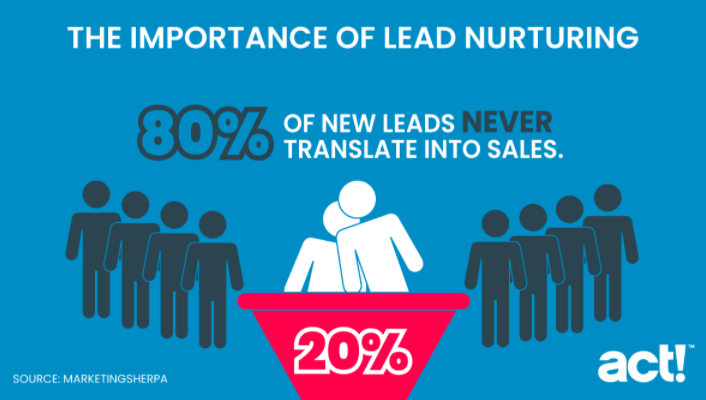
No businesses are exempt from the need to improve sales and marketing activities from time to time. While the abundance and complexity of modern marketing strategies may be daunting, they are necessary to meet the complex requirements of modern customers. The one-trick-pony approach is redundant, so it is smart to implement powerful marketing strategies like lead nurturing.
Knowing how to nurture leads effectively is a major string to your bow. Lead nurturing refers to the development of relationships with your customers and prospects throughout the entire process of interaction with your brand. According to MarketingSherpa, 65% of B2B marketers have not yet established lead nurturing. It, therefore, stands to reason that doing so will put you one step ahead of your competitors.
What is a lead nurturing campaign?
A lead nurturing campaign aids effective communication with your prospects. It focuses on understanding the needs and preferences of prospects so that you can be ready with relevant answers and information. This way you are better equipped to build relationships with them from the offset.
This eventually converts inbound traffic into sales, and eventually, customer loyalty. The most important thing to remember is that the relationship comes first, as it is all-important to the sale. A lead is not yet a customer because they are still in the decision process, but by assisting them with relevant information and support, they become ready to make a purchase.
The below tips will help you to construct an effective lead nurturing campaign:
1. Personalize emails to meet individual needs
By making use of your metrics and segmenting email lists according to specific interests and behaviors, you can tailor your emails to appeal to specific prospects. They will be far more interested if they feel that the communication was more personal than general.
Sending emails out from an employee or department name rather than sales@businessname.com will have a better impact, and don’t forget to include the prospect’s name in the email. Also include any other personal information you have gained; that might be location, company or a specific interest.
2. Use drip marketing tactics to keep leads engaged
It is helpful to send out automated emails in response to certain user actions or behaviors. For instance, if a lead repeatedly visits a specific page, or downloads something from your site. They then receive an email relevant to this, encouraging them to explore further or offering valuable information.
This is known as drip marketing, and there is an art to it. When used in conjunction with personalized communications, drip marketing keeps leads engaged. If you are interested in finding out more about what drip marketing is and when to use it, check our article out.

3. Offer information according to the customer’s journey
Targeted information is a valuable tool. Your email lead nurturing will benefit greatly from an understanding of your customer’s journey. You can figure out what exactly they are looking for and expecting from your brand and by giving them precise information relevant to their requirements, you are much more likely to convert them into customers. There are three phases that a lead goes through before becoming a customer:
- Awareness phase
- Consideration phase
- Decision phase
In the awareness phase, leads will benefit from receiving articles and information relevant to their interests. In the consideration phase, it might be more in-depth or practical information and advice; e.g. a place on a webinar, or a demo of some kind. During the decision phase, they might want to know how others felt about the product. You could send reviews, testimonials or stories. Offers are always helpful, and don’t forget to try and capture more information at every step of the way by asking the right questions.
We recently delved into the art of customer journey mapping, which is a strategy for boosting sales through improved customer experience. This in itself is a very effective lead nurturing tool as it helps you to see things from your leads’ perspectives and predict future behavior.
4. Time your communications carefully
Nobody wants to be spammed and even though targeted emails might be more interesting, too many will start to feel like pressure to buy. Leads are not committed to your brand yet, so the process must be subtle and gentle. Unsubscribes are the last thing you need, so daily emails are a no-no. An effective lead nurturing email schedule will simply keep you at the forefront of your prospects’ minds while allowing them some breathing space to think about what you’re putting their way.
As mentioned in points 1 and 2, targeting is important. Don’t send every single lead every single email; they will not all be in the same place on the customer’s journey at the same time. Instead, send emails out to segments and groups organized according to personal circumstances and interests.
If you’re finding that some leads aren’t opening communications, you can try and re-engage from time to time. Again, it should be done with appropriate timing. There are various tactics you can use for this:
- Put the focus on your lead by asking for their opinions or feedback
- Incentivize leads with targeted offers
- Make it seem urgent with compelling subject lines
5. Aim to capture attention immediately
From a business point of view, focus will be on the purchase. However, it is not necessary to wait until intent to purchase is clear before nurturing a lead. As soon as you notice any expression of interest, you’re good to go. For example, when a prospect subscribes to a blog.
This would be a good time to start sending emails with relevant content and information around that area of interest. You might introduce some products at this point, perhaps with a discount or offer. Don’t forget to include a call to action, whether that is an invitation to learn more, or to give an opinion. Early engagement leads to faster conversions.
6. Tailor your content to prospects’ pain points
As the focus should be on customer experience, by learning about what is important to prospects, you can fine-tune new content to provide valuable solutions for their pain points. Knowing what your prospects are struggling with puts you in a prime position to become an asset, and is much more likely to convert them into customers.
Some of the most useful tools for understanding prospects’ pain points are analyzing metrics and developing customer journey maps. You can then create blogs, web pages and even products that meet their needs.
7. Extend your lead nurturing beyond email
Email lead nurturing is certainly a powerful tool, but it is only one of many ways to nurture leads. Marketing messages can appear in various places without being generic. For example, personalize your site pages with a well-placed dynamic call-to-action here and there, or design specific landing pages that would appeal to certain types of visitor.
It is important to work this in reverse too; for instance, you don’t want to keep asking subscribers to subscribe, and you won’t want to present product information to those who have already bought that product. One example would be tailoring site pop ups to handle this.
8. CRM lead nurturing
There is method of nurturing leads quickly, easily and effectively with minimal effort on your part. A powerful CRM software makes lead nurturing easy, saving precious time for other business activities. It contains integrated email marketing capabilities that help you to set up automated campaigns that are triggered the moment a new contact enters your database.
Through an integrated template editor you can send out tailored emails and monitor the way your prospects respond. This helps you to refine the process even further, leading to faster conversions and loyal customers. Lead nurturing doesn’t have to be hugely time consuming, but it is more necessary than ever. Act! is here to help you out, so get in touch if you have any questions.






